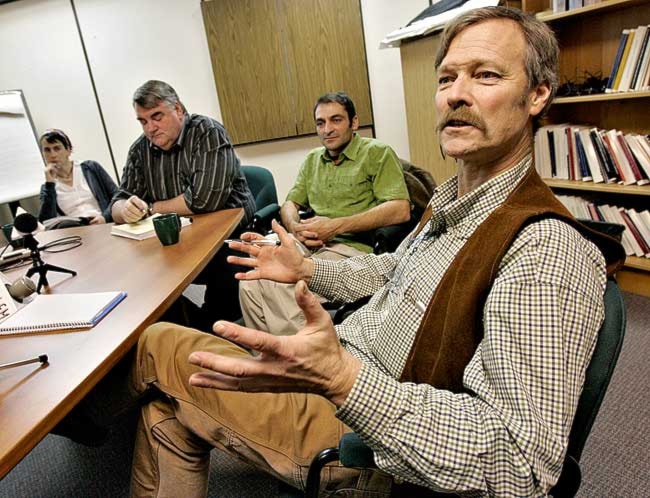The Peel watershed land-use plan is about to enter its toughest phase yet.
The final recommended plan, tabled to Yukon and First Nation governments by the Peel Watershed Planning Commission two weeks ago, hardened differences between First Nations, miners and environmentalists, the commissioners warned at a news conference on Friday.
Now it’s up to the Yukon, Na-Cho Nyak Dun, Tr’ondek Hwech’in and Vuntut Gwitchin governments to accept, amend or reject the plan over the next few months.
And they will likely have to contend with some disparate interests, said commissioners.
“Our experience was there was not a lot of negotiating to be done,” said Dave Loeks, one of the commissioners who attended a news conference Friday.
“I’d be very surprised if the logic of the situation is any different for them from what it was for us.”
“Somebody is going to have to make some tough calls.”
The plan suggests protecting 80 per cent of the 68,000 square-kilometer region from industrial development.
It was a major change from the most recent draft, released in the spring, which tentatively recommended 60 per cent protection.
“There’s substantial difference between the two,” said Loeks.
The debate over the Peel split into two clusters, he said. Heritage, culture and environment boosters fell in one camp, while industrial development in the other.
The first draft was meant as a compromise between the two camps.
“We tried to come up the middle,” said Loeks. “The response to that plan, from almost all sectors, was that they hated it.”
At an open house meeting in Whitehorse last spring, miners, environmentalists and First Nations all blamed the commission for not listening to them.
“When you got really deep into those responses, it was clear that nobody wanted to compromise,” said Loeks. “And that might have been because nobody really could compromise and still preserve their interests.”
Roads were the most divisive consideration in the plan. First Nations felt road building would bring more human impact in its wake. Mining interests argued roads were integral to any exploration company’s economic value.
“As a commission, we felt we were at a fork in the road,” said Loeks. “Or a fork in the trail, if you want to put that way.”
Rather than pick sides, the commission decided to write a plan that preserved options for the future.
“Going the way we did, with the high degree of protection, in our view, is a conservative approach because those options still remain for society to choose if we want to,” said Loeks.
While the Yukon never made any public disclosure over what they wanted in the plan, the First Nations put forward a united front demanding strong protection in their homeland.
“Since planning is a creature of the UFA, it really requires us to pay special attention to the stated interests of the First Nations,” he said. “So nothing swayed us, it was really the logic of the situation.”
Those clashes will likely continue between the governments, said Loeks.
The governments will now negotiate any changes to the final recommended plan. All four governments have to agree to a finalized plan for it to be accepted.
Partial acceptance is possible, but it will likely damage relations between the Yukon and First Nation government.
If the Yukon government rejects the plan, but the First Nations accept it, the recommended plan could be applied to the three per cent of land owned by the First Nation governments.
On the other hand, should the First Nations reject it, the Yukon government could apply the plan to the 97 per cent of the Peel watershed that it owns.
“That could have unknown repercussions around the relations between these various governments,” said Loeks.
It could undermine the progress of modern land claims, rendering them little more than political window dressing.
If the governments reject the plan outright, the Yukon wilderness will slowly lose its worth, said Loeks.
“If they shelved it and we proceeded with basically the status quo, with the land managed as it is, then, over a period of time, the values, the wildlife values, the cultural values, the heritage values, those things called landscape values would degrade,” he said.
“The status quo means long-range degradation.”
Contact James Munson at
jamesm@yukon-news.com
